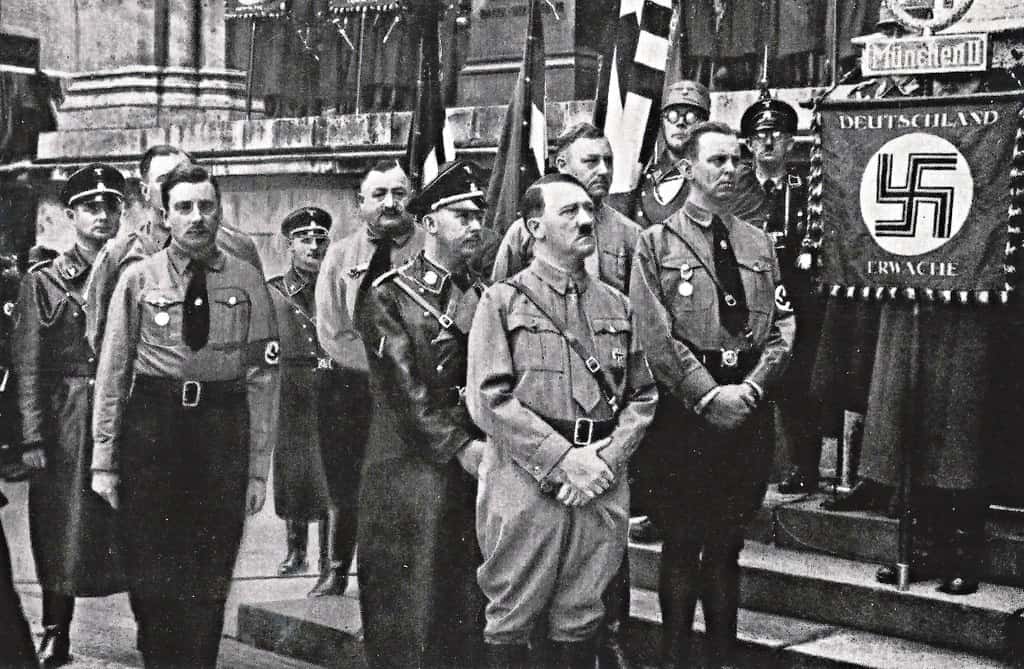Has ‘The Book Thief’ got you stealing ideas and quotes from your friends’ essays? Fret not! We have a summary of The Book Thief with its key themes, characters and more to help you with your analysis.
We’ve also included a TEE table and a sample paragraph that you can download so you have a better understanding of how to analyse an excerpt from the text.
Let’s get started on crafting an analysis of The Book Thief!
The Book Thief Summary
Key Characters in The Book Thief
Context
Symbols in The Book Thief
Themes Explored in The Book Thief
Analysis of The Book Thief
Summary of The Book Thief
The Book Thief is a historical fiction written by Australian author, Markus Zusak and set during the height of WWII from 1939-1945. Narrated by Death, the novel follows the story of nine year old Liesel Meminger.
We are introduced to our protagonist on a train when her brother suddenly dies. Liesel and her mother bury the body where Liesel steals a book from the gravediggers.
Liesel and her mother continue travelling to Molching where she will be raised by foster parents, Hans and Rosa Hubermann. Liesel had never learned how to read and when she is sent to school, she is made fun of.
Hans realises and teaches her how to read from The Grave Digger’s Handbook, the book she stole from her brother’s burial.
As Liesel grows closer to Hans and Rosa, she also begins to help Rosa collect the laundry from various neighbours — one of them being the mayor’s home. One day, the mayor’s wife, Ilsa Hermann invites Liesel into the study where she admires the bookshelves. Noticing her keen interest in the books, Ilsa allows Liesel to read there.
Liesel Growing Up
However, the Nazis become increasingly prominent in Molching with Jewish stores destroyed and the children being required to join the Band of German Girls and Hitler Youth. During this time, Liesel matures and begins to realise the horrors of Nazi Germany and the Hubermanns also hide Max Vanderburg, a Jew.
Image sourced from Wikimedia Commons
While initially scared of Max, Liesel soon forms a close friendship with him. She tells him about her day and brings him presents.
Max, too, enjoys telling stories and frequently tells Liesel the stories he knows. For her birthday, he writes a book for Liesel which details his life, which includes her and the Hubermanns too.
As the war continues, food rationing and money becomes scarce. Thus Rosa loses her laundry jobs, including Ilsa’s.
One night, Liesel sneaks in through a window and takes a book from Ilsa Hermann’s library, becoming a book thief. After stealing several books from them, Liesel finds a Dictionary and Thesaurus left by the window where Ilsa tells Liesel she is aware of her stealing books, and encourages her to come in through the front door.
The Air Raids Begin
Eventually, the air raids begin and Nazi soldiers inspect the Hermann’s basement but conclude it is not deep enough for a bomb shelter. Instead, they have to take shelter at a neighbour’s house and leave Max in their basement by himself.
During one of the air raids, Liesel reads from a book and everyone gathers around her and begins to calm down. It is here that Liesel develops an appreciation and understanding for the power of words and stories.
As the war continues, Liesel begins to see Jewish prisoners being paraded through their town on the way to the concentration camps. Max is no longer safe in the basement of their home and has to flee again. A few days later, Hans and Rudy’s father are drafted into the German army.
One day, Ilsa gives Liesel a blank notebook so she may write her own story. While she is writing in her basement, her neighbourhood is bombed and Hans, Rosa and Rudy are killed.
Liesel finds Rudy’s body and gives him the kiss he always wished for and when she is rescued, Liesel leaves behind her book called ‘The Book Thief’. Death keeps the book.
The novel ends with Liesel living with Ilsa and the mayor and when the war ends, she meets Max again. Liesel lives to old age, and when Death comes to collect her soul, he returns the book which she wrote.
Key Characters in The Book Thief
Death
Death is the narrator of the book and we see many events through his viewpoint as well. Death is an inevitable part of life and he seems to witness many of the saddest yet heartwarming moments of humanity, but also the cruelty and ugliness in us.
Rather than portraying Death as a figure to be feared and dreaded, Zusak also humanises Death portraying him as a character with empathy.
Liesel Meminger
Liesel is 9 years old when we first meet her and we follow her as she grows up in the midst of WWII. We watch her gradually mature and realise the realities of the world she is growing up within.
While Liesel is unable to read when we first meet her, she has always seemed to have a desire to read and develops an appreciation and awareness of the power of words for both kindness and cruelty.
Hans Hubermann
Hans is Liesel’s foster father and was a former soldier during WWI. He is warm-hearted and plays the accordion, which Liesel associates with safety and comfort.
He teaches her how to read and is a highly empathetic man, sheltering Max during the War and attempting to help one of the Jewish prisoners in a parade that passes through Molching.
Rosa Hubermann
Rosa is Liesel’s foster mother and appears to be a strict and impatient lady at first. However, she is a loving wife and mother — while not as affectionate as Hans, it is clear that she cares about Liesel through the way she nags.
Max Vanderburg
Max is a Jewish man who hides from the Nazis in the Hubermann’s basement. During his time here, he befriends Liesel, bonding over similar struggles they have both experienced but also a shared love for words and stories.
Max writes a book about his life and includes Liesel and the Hubermanns in it, presenting it to her as a present.
Ilsa Hermann
Ilsa is the Mayor’s wife and one of Rosa’s laundry customers. Liesel meets her while collecting and delivering the laundry, and one day Ilsa invites her into the study which is filled with books.
Noticing Liesel’s amazement, Ilsa allows her to read in the library with her and helps to cultivate her love of reading. Later on, Ilsa presents Liesel with a book for her to write her own story in.
Context
The Book Thief is set in Molching, a small town near Munich during Nazi Germany. The majority of the book’s events take place between 1939-1945, during WWII.
By this time, Hitler has well established the Nuremberg Laws, which removed the rights of many Jewish people. In 1939, the Nazi regime was becoming increasingly hostile and concentration camps were set up in Germany.
During the years of the war, many German men lost their lives on the Eastern Front. For those who were allowed to stay at home, like older men, women and young children, air raids, food supply and finance were often precarious during the war.
Many fictional books written about the events of WWII are often told in the point of view of Holocaust victims, retelling the horrors that occurred in Nazi Germany. Markus Zusak chooses to explore the German perspective and their experience of this period in history to demonstrate what life was like for those who disagreed with the Nazis but found themselves having to comply in order to keep themselves and their family safe.
Image sourced from Flickr
If your school is studying The Book Thief in relation to the context of Nazi Germany in WWII, it is important that you know the events of the war really well (don’t be afraid of flipping through your notes of history!).
As a rule of thumb, it is best to introduce the historical context within your thesis statement and ensure that each paragraph contains at least one ‘Explanation’ that clearly links back to the events of WWII or how it has impacted the lives of the character.
Symbols in The Book Thief
Books
Books represent knowledge, power, and the potency of words. Liesel’s journey begins with the stolen “The Grave Digger’s Handbook,” symbolizing her entry into the world of literature. Throughout the story, books offer solace, education, and connections. They embody the potential for both positive and negative influence, showcasing the impact of words on individuals and society.
In a time of turmoil, books become tools of resistance, signifying defiance against ignorance and oppression. They provide hope and escapism, offering a sense of normalcy and humanity amidst chaos. Hans teaching Liesel to read and write secretly in their basement epitomises this resistance and the significance of knowledge in challenging authority.
Death
Death serves as the narrator, offering a unique perspective that combines insight with detachment. Its presence throughout the story underscores the inevitability of mortality and the universal experience of loss during wartime. Despite its role as the harbinger of the end, Death’s observations often convey empathy, emphasising the resilience and beauty found within individuals even amid tragedy.
Death symbolises transition, guiding souls from life to afterlife. Its narration allows the exploration of themes surrounding mortality, loss, and the fragility of life, providing a deeper understanding of the human condition.
Themes Explored in The Book Thief
Mortality
Narrated by Death and set during WWII, the theme of mortality is pertinent throughout the whole novel. All the characters in the book have encountered death closely, including Liesel herself where her younger brother dies at the beginning of the book.
Death is not a stranger and the characters are vividly aware of their own mortality, as well as the increasing number of lives that have been lost during the war.
Power of Reading and Writing
Throughout the novel, the power of stories is evident through the recurring motifs of books and writing as symbols of personal agency and expression. Various characters throughout the book read, write or share stories with each other, allowing them to connect with each other or to control their own narratives even when all hope seems lost.
The power of words is portrayed in a paradoxical manner throughout the book. Liesel, and many of the people around her, use words to bring comfort and build relationships with each other.
A particularly powerful moment is during one of the air raids when Liesel reads a book out loud and everyone gathers around her to listen during this terrifying moment. However, this is contrasted by Hitler who used words to incite violence during WWII.
The power of words is further reinforced during the novel through book burnings and how various characters throughout the novel encourage Liesel to read, and write her own story.
Paradox of Humanity
The Book Thief explores the paradox of humanity, examining our inherent kindness alongside our immense capacity for cruelty. Throughout the novel, there are small acts of kindness among the residents of Molching.
From Hans patiently teaching Liesel how to read, the Hubermanns hiding Max, Liesel bringing snow into the basement so she can build a snowman with Max or Ilsa gifting her a dictionary instead of getting angry for stealing books — there are small acts of kindness that occur throughout the novel in contrast to the vast cruelty that is occurring in Nazi Germany.
Writing about the Themes
The text contains many contrasting themes and elements for you to explore, from the power of words, mortality and the paradoxes of human nature. When writing in relation to a theme, make sure that your thesis and point sentences relate to the theme clearly, this will make it easier for you to choose your quotes and will help to guide your analysis.
You could include your personal observations for essays that are centred on a theme too, as long as you remember to back these up through the TEE format. This will give your essay a unique perspective and your English teacher will be sure to appreciate it too!
Need to know how to write a feature article for English on ‘The Book Thief’? Look no further than our amazing article!
How to Analyse The Book Thief in 3 Steps
Step 1: Choose your Example
When picking an example ensure that you are able to identify a technique in the text.
For this example, I have chosen to analyse the following quote which states:
“I guess humans like to watch a little destruction. Sand castles, houses of cards, that’s where they begin. Their skills are their capacity to escalate.”
Step 2: Identify your technique(s)
Ensure that the technique you choose for your quote supports your analysis or helps you to build your argument.
In the above quote we can find tricolon, listing and Death’s colloquial yet darkly humorous tone. Set against the context of WWII, foreshadowing may also be used depending on how you choose to analyse the quote!
Step 3: Write the analysis
When writing the analysis, focus on the effect of the technique and how it supports your argument.
For this quote, let’s analyse it in relation to humanity’s paradox — our great capacity for kindness and cruelty.
Death’s ironic tone in the quote “I guess humans like to watch a little destruction. Sand castles, houses of cards, that’s where they begin. Their great skill is their capacity to escalate” highlights capacity’s paradoxical nature and our capacity for both cruelty and kindness through the use of tricolon. Furthermore, Death foreshadows the inevitable violence that will occur during WWII, demonstrating how harmless acts like destroying “sandcastles” can “escalate” into extreme cruelty if humanity does not remain vigilant about their behaviour.
Need some help analysing other texts?
Check out other texts we’ve created guides for below:
- All the Light We Cannot See
- Lord of the Flies
- King Richard III
- Hamlet
- Jane Eyre
- In Cold Blood
- To Kill a Mockingbird
- Amélie
- Pride and Prejudice
- Rainbow’s End
- Jasper Jones
- Things Fall Apart
- Mrs Dalloway
Are you looking for some extra help with your analysis of The Book Thief?
We have an incredible team of English tutors and mentors!
We can help you master your analysis of The Book Thief by taking you through the summary, context, key characters and themes. We’ll also help you ace your upcoming English assessments with personalised lessons conducted one-on-one in your home or online!
We’ve supported over 8,000 students over the last 11 years, and on average our students score mark improvements of over 20%!
To find out more and get started with an inspirational tutor and mentor, get in touch today or give us a ring on 1300 267 888!
Tiffany Fong is currently completing a double degree in Media and Communications with Law at Macquarie University. She currently contributes to the university zine, Grapeshot where she enjoys writing feature articles, commentary on current affairs or whatever weird interest that has taken over her mind during that month. During her spare time, Tiffany enjoys reading, writing, taking care of her plants or cuddling with her two dogs.








